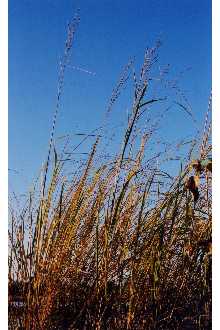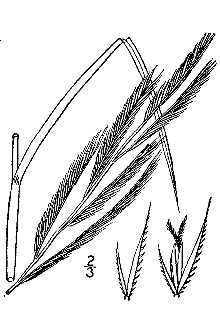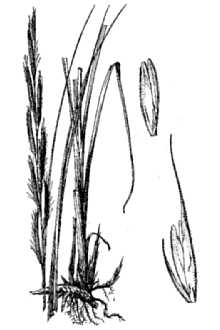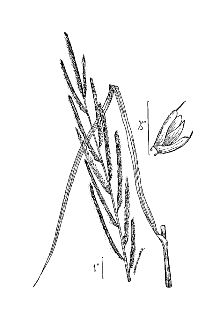Prairie Cordgrass
Scientific Name: Spartina pectinata Bosc ex Link
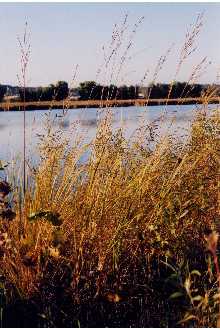
| General Information | |
|---|---|
| Usda Symbol | SPPE |
| Group | Monocot |
| Life Cycle | Perennial |
| Growth Habits | Graminoid |
| Native Locations | SPPE |
Plant Guide
Description
General: Prairie cordgrass is a warm-season perennial grass. It is native to the tall grass prairies of most of the United States and Canada. It has an average height of 3 to 8 feet (Johnson and Larson, 1999). The leaf blades, 0.1 to 0.5 inches wide and up to 30 inches long, are coarse, very tough, and thick. The margins of the leaf are serrated and sharp. Stems are stiff. It is strongly rhizomatous with very tough, scaly rhizomes. Strong rhizomes with the ability to grow 5 to 10 feet per year separate this grass from the other desirable native warm season grasses (Bush, 2000). Seedheads are composed of 10 to 20 spikes attached to the main stem. Each spike has up to 40 spikelets, all growing in two rows on the side of the spike away from the stem. The seeds are flat, paper-like with barbed awns that attach firmly to fur or fabric. There are approximately 183,000-197,000 seeds per pound (Bush, 2000). Distribution: Prairie cordgrass grows throughout the Northeast, Great Lakes, and Midwest States, as well as most other states throughout the country. For current distribution, please consult the Plant Profile page for this species on the PLANTS Web site. Habitat: Prairie cordgrass is found in wet meadows, sloughs, potholes, and drainage ways. It also occurs in floodplains and back dune areas (Bush, 2000). It is associated with various species including sedges and rushes.
Adaptation
Prairie cordgrass has a broad climatic adaptation. It will grow in seasonally dry sites, tolerates alkaline conditions and high-water tables but is intolerant of prolonged flooding. The rapid seedling development of this species enables it to avoid frost-heaving problems on wetter soils (Bush, 2000). It will grow on a wide array of soil types. Anderson et al. (2014) demonstrated that prairie cordgrass has some degree of salt tolerance by conducting greenhouse germination and plant growth experiments.
Uses
The stiff stems, vigorous rhizomes, and robust size of this species are useful in stabilizing soil, dissipating wave energy, and providing cover. • wetland restoration and enhancement • streambank stabilization • windstrip barrier • filterstrip • riparian buffer • prairie landscaping Natural Resources Conservation Service Plant Guide Photograph of prairie cordgrass inflorescence. Photo taken at the Big Flats Plant Materials Center in Big Flats New York, 2013 • wildlife habitat – nesting and cover • forage – very early season only • spillway and dam cover • biofeedstock production
Ethnobotany
Native Americans used prairie cordgrass as a building material for shelters. The Ponca used it as thatching for roofs and as a fiber to support earth lodge structures. The Omaha also used it to build permanent villages of earth lodges (Kindscher and Noguera, 2002). Prairie cordgrass was also used by early European American pioneers as roof thatch and to cover haystacks and corn cribs (Weaver, 1954).
Status
Threatened or Endangered: Prairie cordgrass is assigned a State Rank of S2 – Imperiled in Washington State. Washington Natural Heritage Program defines imperiled species as being “at high risk of extirpation due to restricted range, few occurrences, steep declines, severe threats, or other factors” (WNHP, 2019). It is not a federally listed species (USFWS, 2021). Wetland Indicator: FACW for Great Plains, Midwest, and Northcentral and Northeast regions; OBL for all other regions in which it occurs (USACE, 2018). Weedy or Invasive: This plant may become weedy or invasive in some regions or habitats and may displace desirable vegetation if not properly managed. Please consult with your local NRCS Field Office, Cooperative Extension Service office, state natural resource, or state agriculture department regarding its status and use. Please consult the PLANTS Web site (http://plants.usda.gov/) and your state’s Department of Natural Resources for this plant’s current status (e.g., threatened or endangered species, state noxious status, and wetland indicator values).
Planting Guidelines
Vegetative propagation: The strong rhizomes can be used for propagation. The ideal piece of vegetative material is a “J” hook piece of rhizome with buds and 2 to 12 inches of dry stem. Other rhizome pieces can be used if there are roots and at least one bud. The stem length is not critical for growth, but, if attached, makes planting and handling easier. Vegetative Source: • Local sites such as a ditch or wet meadow • Nursery propagation bed material is usually more uniform, and plants tend to be larger and stronger making them easier to handle and improving survival Harvest Date: • Spring (early April-early June) • Fall (dormant-October/November)-Rhizomes dug in the fall should be stored in controlled conditions of temperatures near freezing. Do not allow pieces to become dry or warm. Harvest Method: Vegetative material can be dug by hand or with an undercutter, disk, or plow. Depth of digging will vary depending on site conditions. In older stands, the intertwined rhizomes are course, stiff, and have sharp buds. Material most easily processed is from younger growth found on the outside edge of an old stand or from newer plantings. Plants 2 to 3 years old would be the easiest material to handle and process. Once rhizomes are dug, pieces should be cut as described above. It is important to keep processed rhizomes cool and moist until planting. Planting Method: Rhizomes should be planted with the shoot upright. Roots and at least part of the shoot should be buried. The average planting depth is 3 to 6 inches. Rhizomes have been successfully planted using a tree planted and by hand planting. Air space around the planted rhizomes should be removed by packing. Another method of establishment is to scatter the rhizomes, cover, and firm the planting bed. Plant Spacing: This will vary depending on the purpose of the planting and site conditions. Recommended spacing between rows for seed increase fields and nursery beds is 6 to 15 An ideal “J” hook rhizome planting unit. Photo taken at the USDA NRCS Bismarck Plant Materials Center, North Dakota
Management
Seedling vigor is moderate, and seed often germinates throughout the course of the summer. Seedlings develop slowly. Stands are established more quickly by planting vegetative material compared to seeding. Adequate water at planting time is critical for establishment of seed and vegetative material. Once the stand is established, watering is less critical. Due to the rhizomatous growth and size of the plants, weed competition is not usually a problem in established stands. The first few years of establishment by seed may require weed control if heavily infested. Prairie cordgrass has few management needs. Mowing of prairie cordgrass more than once per season can reduce vigor.
Pests and Potential Problems
Pests do not appear to be a problem for vegetative material. Seed predation by insects is a problem in most areas except the extreme northern climates of the United States. Larvae of the tortricid moth (Aethes spartinana) feed on the florets of prairie cordgrass and have been found to be commonly responsible for floret damage and reduced seed yields (Prasifka et al., 2011).
Environmental Concerns
Concerns
Concerns
This plant may become weedy or invasive in some regions or habitats and may displace desirable vegetation if not properly managed. Please consult with your local NRCS Field Office, Cooperative Extension Service office, or State natural resource or agriculture department regarding its status and use. Weed information is also available from the PLANTS database. Seed head at harvest. Top glume longer than lower glume. Photo taken at the USDA NRCS Bismarck Plant Materials Center, North Dakota
Control
Please contact your local agricultural extension specialist or county weed specialist to learn what works best in your area and how to use it safely, Use soil moisture sensors to measure the soil moisture of Prairie Cordgrass., Always read label and safety instructions for each control method,
Seeds and Plant Production
Plant Production
Plant Production
Seed production fields: Seed fields established from rhizomes will produce some seed the first year. Seed fields established from seed usually take 2 to 3 years before producing a seed crop. The seed typically matures within a week or two of frost (Bush, 2000). Seed can be combined after the first frost in northern regions and shattering is generally not a problem. Seed yields at the Bismarck, North Dakota Plant Materials Center have varied from 30 to 75 PLS lbs/acre with wide row spacing. Plantings used for seed production can become quite sod-bound after 5 years and seed production inhibited. Rhizomes will need to be separated by some means or a new field established. Vegetative production fields: Rhizomes can be harvested from vegetative production fields for propagation using manual hand tools or more efficiently using standard agricultural nursery equipment such as an undercutter. Maintaining row spacing that suits harvest equipment size will ease the harvest process by preventing the production field from becoming sod-bound. Sod-bound production fields can prove more cumbersome to harvest and the propagules produced may be more difficult to process and divide. Cultivars, Improved, and Selected Materials (and area of origin) Red River Germplasm prairie cordgrass is a selection named and released by the Bismarck, North Dakota Plant Materials Center. It is a composite of plant materials from Grant County, Minnesota; Cass and Grand Forks Counties in North Dakota; and Day County in South Dakota. Select Class seed and vegetative material is available in the commercial market of this selection. Atkins Germplasm prairie cordgrass is a selection named and released by the Manhattan, Kansas Plant Materials Center. Material for this release originated from Washington County, Nebraska. This is a Select Class vegetative release. There is no seed produced or available. Vegetative material is available for increase. Kingston Germplasm prairie cordgrass is a selection named and released by the Big Flats Plant Materials Center, in Big Flats, New York. Material for this release originated from riparian areas and coastal areas, in Maine, New Hampshire, and Massachusetts. This is a Select Class vegetative release. There is no seed produced or available, currently.
Vegetative
material is available for increase. Southampton Germplasm prairie cordgrass is a selection named and released by the Cape May Plant Materials Center, in Cape May, New Jersey. Material for this release originated from 3 areas around the Mecox Bay area, New York, in eastern Long Island. This is a Select Class release. Seed and vegetative material is available by contacting the Cape May Plant Materials Center, in Cape May, New Jersey. Cultivars should be selected based on the local climate, resistance to local pests, and intended use. Consult with your local land grant university, local extension, or local USDA NRCS office for recommendations on adapted cultivars for use in your area.
Literature Cited
Bush, T. 2000. Plant fact sheet for Spartina pectinata Bosc ex Link, Prairie cordgrass. USDA-Natural Resources Conservation Service, Somerset, Plant Materials Program, Rose Lake Plant Materials Center, East Lansing, MI. Houseal, G.A. 2007. Tallgrass Prairie Center’s Native Seed Production Manual. University of Northern Iowa, Tallgrass Prairie Center, Cedar Falls, IA. Johnson, J.R. and G.E. Larson. 1999. Grassland plants of South Dakota and the northern Great Plains. South Dakota State University College of Agriculture and Biological Sciences. B566(rev.) Brookings, SD Kindscher, K. and E. Noguera. 2002. Cultural use of plants from the Baker Wetlands. University of Kansas. Lawrence, KS. Prasifka, J.R., D.K. Lee, J.D. Bradshaw, A.S. Parrish, and M.E. Gray. 2011. Seed reduction in prairie cordgrass, Spartina pectinata Link., by the floret-feeding caterpillar Aethes spartinana. Bioenerg. Res. 5: 189-196. US Army Corps of Engineers (USACE). 2018. National Wetland Plant List v3.3 – Species Detail Tool. [Online]. Available at https://cwbi-app.sec.usace.army.mil/nwpl_static/v34/home/home.html (accessed 10 May 2021). USDOD-Army Corps of Engineers. Washington, DC. US Fish and Wildlife Service (USFWS). 2021. ECOS: Environmental Conservation Online System [Online]. Available at https://ecos.fws.gov/ecp/report/species-listings-by-tax-group?statusCategory=Listed&groupName=All%20Plants (accessed 10 May 2021). United States Department of Interior, Washington, DC. Washington Natural Heritage Program (WNHP). 2019. 2019 Washington Vascular Plant Species of Special Concern. Natural Heritage Report 2019-04. Washington State Department of Natural Resources. Olympia, WA. Weaver, J.E. 1954. North American Prairie. Johnsen Publishing Company, Lincoln, NE. Citation Jensen, N.K. 2006. Plant Guide for prairie cordgrass (Spartina pectinata Bosc ex Link). USDA-NRCS, Bismark Plant Materials Center, Bismarck, ND. Published: May 2006 Edited 24May06 jsp; 17Sep13 sec; 9Jul2021 scs For more information about this and other plants, please contact your local NRCS field office or Conservation District at http://www.nrcs.usda.gov/ and visit the PLANTS Web site at http://plants.usda.gov/ or the Plant Materials Program web site: http://plant-materials.nrcs.usda.gov. PLANTS is not responsible for the content or availability of other Web sites. In accordance with Federal civil rights law and U.S. Department of Agriculture (USDA) civil rights regulations and policies, the USDA, its Agencies, offices, and employees, and institutions participating in or administering USDA programs are prohibited from discriminating based on race, color, national origin, religion, sex, gender identity (including gender expression), sexual orientation, disability, age, marital status, family/parental status, income derived from a public assistance program, political beliefs, or reprisal or retaliation for prior civil rights activity, in any program or activity conducted or funded by USDA (not all bases apply to all programs). Remedies and complaint filing deadlines vary by program or incident. Persons with disabilities who require alternative means of communication for program information (e.g., Braille, large print, audiotape, American Sign Language, etc.) should contact the responsible Agency or USDA's TARGET Center at (202) 720-2600 (voice and TTY) or contact USDA through the Federal Relay Service at (800) 877-8339. Additionally, program information may be made available in languages other than English. To file a program discrimination complaint, complete the USDA Program Discrimination Complaint Form, AD-3027, found online at How to File a Program Discrimination Complaint and at any USDA office or write a letter addressed to USDA and provide in the letter all of the information requested in the form. To request a copy of the complaint form, call (866) 632-9992. Submit your completed form or letter to USDA by: (1) mail: U.S. Department of Agriculture, Office of the Assistant Secretary for Civil Rights, 1400 Independence Avenue, SW, Washington, D.C. 20250-9410; (2) fax: (202) 690-7442; or (3) email: program.intake@usda.gov. USDA is an equal opportunity provider, employer, and lender.
Plant Traits
Growth Requirements
| Temperature, Minimum (°F) | -38 |
|---|---|
| Adapted to Coarse Textured Soils | Yes |
| Adapted to Fine Textured Soils | No |
| Adapted to Medium Textured Soils | Yes |
| Anaerobic Tolerance | High |
| CaCO3 Tolerance | Medium |
| Cold Stratification Required | No |
| Drought Tolerance | Low |
| Fertility Requirement | Medium |
| Fire Tolerance | High |
| Frost Free Days, Minimum | 110 |
| Hedge Tolerance | None |
| Moisture Use | High |
| pH, Maximum | 8.5 |
| pH, Minimum | 6.0 |
| Planting Density per Acre, Maxim | 4800 |
| Planting Density per Acre, Minim | 2700 |
| Precipitation, Maximum | 35 |
| Precipitation, Minimum | 14 |
| Root Depth, Minimum (inches) | 18 |
| Salinity Tolerance | Low |
| Shade Tolerance | Intolerant |
Morphology/Physiology
| After Harvest Regrowth Rate | Moderate |
|---|---|
| Toxicity | None |
| Resprout Ability | No |
| Shape and Orientation | Erect |
| Active Growth Period | Spring and Summer |
| Bloat | None |
| C:N Ratio | High |
| Coppice Potential | No |
| Fall Conspicuous | No |
| Fire Resistant | No |
| Flower Color | Yellow |
| Flower Conspicuous | No |
| Foliage Color | Green |
| Foliage Porosity Summer | Dense |
| Foliage Porosity Winter | Moderate |
| Fruit/Seed Color | Brown |
| Nitrogen Fixation | None |
| Low Growing Grass | Yes |
| Lifespan | Long |
| Leaf Retention | No |
| Known Allelopath | No |
| Height, Mature (feet) | 8.0 |
| Growth Rate | Rapid |
| Growth Form | Rhizomatous |
| Fruit/Seed Conspicuous | No |
| Foliage Texture | Coarse |
Reproduction
| Vegetative Spread Rate | Rapid |
|---|---|
| Small Grain | No |
| Seedling Vigor | Medium |
| Seed Spread Rate | Slow |
| Fruit/Seed Period End | Fall |
| Seed per Pound | 638863 |
| Propagated by Tubers | No |
| Propagated by Sprigs | Yes |
| Propagated by Sod | No |
| Propagated by Seed | Yes |
| Propagated by Corm | No |
| Propagated by Container | No |
| Propagated by Bulb | No |
| Propagated by Bare Root | No |
| Fruit/Seed Persistence | Yes |
| Fruit/Seed Period Begin | Summer |
| Fruit/Seed Abundance | Low |
| Commercial Availability | Routinely Available |
| Bloom Period | Mid Summer |
| Propagated by Cuttings | No |
Suitability/Use
| Veneer Product | No |
|---|---|
| Pulpwood Product | No |
| Protein Potential | Low |
| Post Product | No |
| Palatable Human | No |
| Palatable Graze Animal | Medium |
| Palatable Browse Animal | Low |
| Nursery Stock Product | No |
| Naval Store Product | No |
| Lumber Product | No |
| Fodder Product | Yes |
| Christmas Tree Product | No |
| Berry/Nut/Seed Product | No |

